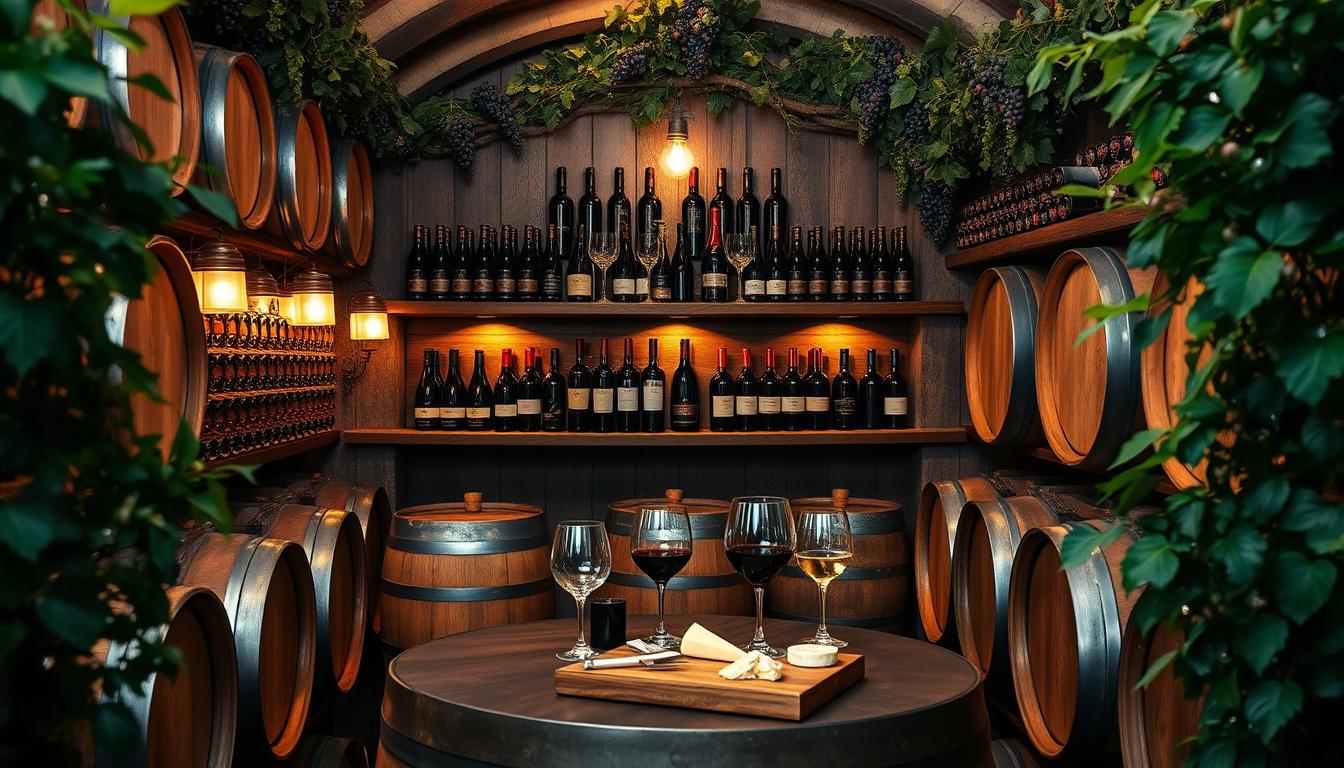Imagine yourself at a table, surrounded by laughter and the clinking of glasses filled with deep crimson, bright white, or sparkling effervescence. Each sip you take unveils a story steeped in history—a journey through ancient civilizations known for their skilled wine production. The beauty of wine culture is not just in the beverage itself, but in the shared experiences that connect people across the globe. The exploration of wine appreciation allows you to immerse yourself in diverse styles and flavors while embracing the artistry that elevates the simple act of drinking into a cherished ritual.
From the noble vine varieties like Sauvignon Blanc and Pinot Noir that flourish in specific regions, to the meticulous practices of winemaking that have been handed down through generations, wine embodies a rich tapestry of tradition and innovation. This culture invites you to dive deeper into understanding the terroir and climate that shape each bottle, while encouraging you to savor moments—whether at a vineyard or a dinner party. Join us on this journey as we uncover the essentials that define wine culture, enriching your palate and your connections with each sip.
Key Takeaways
- Wine culture connects people through shared experiences and traditions.
- Understanding the history of wine enhances your appreciation of this timeless beverage.
- Noble vine varieties contribute to the richness and quality of wines worldwide.
- The role of terroir plays a significant part in defining the diversity of wines.
- Organic winemaking is becoming popular, emphasizing natural methods without artificial components.
- Each bottle holds a story, marked by its region, vintage, and the careful craftsmanship behind it.
- Wine appreciation rituals allow for deeper connections with the art of tasting and pairing.
The History of Wine: A Journey Through Time
Wine history is a rich tapestry woven through centuries, showcasing the evolution of ancient winemaking practices across various civilizations. Evidence suggests that grape fermentation dates back to around 6000 BC in modern-day Georgia, with production techniques gradually spreading to nearby regions like Iran and Armenia by 4000 BC. This early innovation set the stage for a profound legacy in winemaking that would flourish across continents.
The expansion of vineyards and the establishment of Roman viticulture marked a significant turning point. As the Roman Empire spread, so did their winemaking techniques, reaching territories like France, Spain, and Italy. Notably, the Romans constructed temples dedicated to Bacchus, the god of wine, which contributed to the standardization of practices and the growth of wine culture.
During the Middle Ages, the Catholic Church emerged as a key player in preserving and advancing wine history. Monasteries in regions such as Burgundy and Champagne became centers of viticulture, cultivating grapes for both sacramental use and trade. Monastic orders like the Benedictines and Cistercians not only maintained wine production knowledge but also explored the medicinal properties of wine, reflecting its importance in the social fabric of the time.
The Islamic Golden Age produced remarkable advancements in ancient winemaking, despite the prohibition of alcohol in the region. Scholars significantly influenced European practices with new distillation techniques that would later shape modern wine production.
The Renaissance brought about breakthroughs and innovations, including the creation of sparkling wines pioneered by figures like Dom Pérignon. Fortified wines such as Port, Sherry, and Madeira also emerged, enhancing the diversity of offerings available to wine enthusiasts.
As European explorers ventured into new territories, they carried vines to the Americas, South Africa, and Australia, facilitating global winemaking. The Industrial Revolution further propelled this spread, ensuring that wine culture continued to flourish across continents.
In the mid-19th century, the phylloxera epidemic devastated European vineyards, prompting a critical adaptation. Grafting European grapevines onto American rootstocks became essential for saving the industry, a notable chapter in wine history.
Today, the world’s wine culture showcases a delightful array of styles and traditions, reflecting centuries of development. Understanding this journey through time enhances your appreciation for the complex and vibrant world of wine. The diversity in grape varietals, production techniques, and aging processes allows wine enthusiasts to explore wine tasting traditions from all corners of the globe. This exploration exposes individuals to new flavors and aromas, creating a deeper connection to the rich history and cultural significance of wine. By experiencing the unique characteristics of different wine regions, one gains a deeper appreciation for the artistry and craftsmanship that goes into each bottle.

Understanding Wine Regions Across the Globe
Wine regions around the world offer a diverse array of flavors and styles, largely shaped by their unique climates, soil types, and local grape varieties. France stands out as a pioneer in this realm, producing prominent French wines from its celebrated regions such as Bordeaux, renowned for its Left Bank and Right Bank variations, and Burgundy, famous for its exquisite Pinot Noir and Chardonnay. Each of these regions reflects the rich terroir and historical significance of winemaking in France.
Italy boasts a remarkable selection of over 350 grape varieties, showcasing exceptional Italian varietals. Regions like Tuscany are synonymous with the Sangiovese grape, integral to famous wines like Chianti and Brunello di Montalcino. In Piedmont, Barbera and Nebbiolo create depth and complexity for wine lovers. Italian winemaking traditions resonate with both history and artistry, making this region a cornerstone of global wine culture.
Spain has its own story to tell, particularly known for its vibrant Spanish vineyards. The Rioja region excels in producing Tempranillo-based reds that can range from juicy and fruity to deeply complex. This diversity reflects the country’s dedication to growing quality grapes and cultivating unique wine styles. Spain’s wide range of climates contributes to this extensive differentiation, nurturing an environment where innovative winemaking practices thrive.
Across the ocean, California’s wine regions have gained international acclaim. Napa Valley shines for its rich Cabernet Sauvignon and elegant Merlot, while Sonoma County expands the narrative with its diverse offerings, including robust Zinfandel and crisp Chardonnay. Recognizing the importance of viticulture and winemaking techniques enhances your understanding of these regions and their significance on the global stage.
As you explore these vibrant wine regions, each bottle of wine tells a tale of tradition, passion, and the artistry of winemaking. Engaging with these cultures deepens your appreciation for the history and beauty behind each unique varietal.
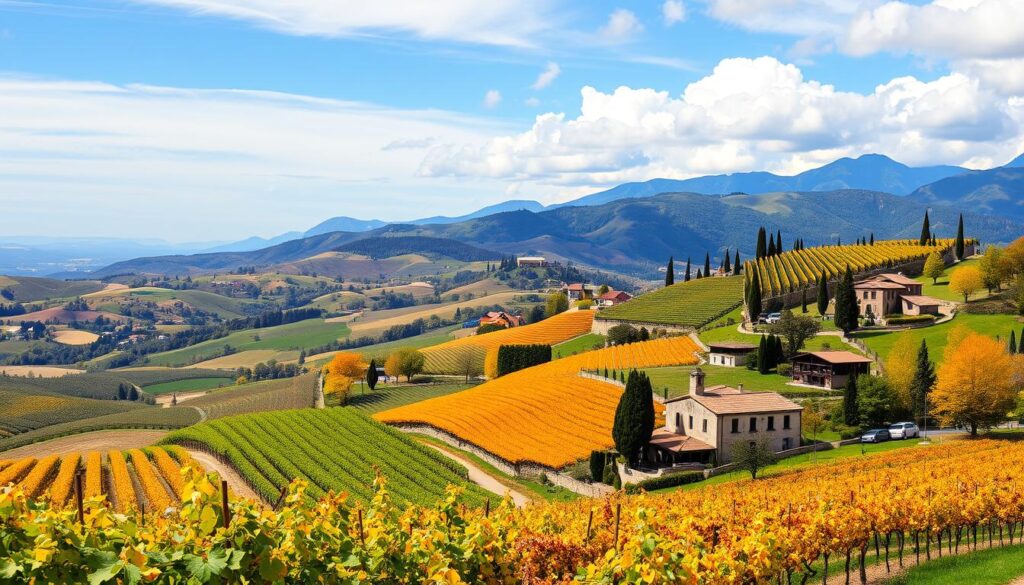
| Wine Region | Key Varietals | Main Characteristics |
|---|---|---|
| Bordeaux, France | Cabernet Sauvignon, Merlot | Rich, full-bodied, complex |
| Burgundy, France | Pinot Noir, Chardonnay | Elegant, reflective of terroir |
| Tuscany, Italy | Sangiovese | Fruity, earthy, structured |
| Rioja, Spain | Tempranillo | Vibrant, rich, versatile |
| Napa Valley, California | Cabernet Sauvignon, Merlot | Bold, globally recognized |
| Sonoma County, California | Zinfandel, Chardonnay | Diverse, flavorful |
Exploring the Art of Wine Production Techniques
The art of winemaking is a captivating blend of tradition and innovation. Wine production techniques are essential for transforming grapes into the exquisite beverages enjoyed around the world. A fundamental step in this process is fermentation, where grape sugars are converted into alcohol and carbon dioxide. Understanding how fermentation influences the final product is key to appreciating the complexities of your favorite wines.
Aging, particularly in wooden barrels, adds rich flavors and aromas to the wine. The choice of barrel, Oak or other types, can profoundly affect the wine’s character. Equally important is the process of aeration, which involves exposing wine to air. This technique enhances its aromas and releases flavors, allowing the wine to reach its full potential when poured into a glass.
As you explore these wine production techniques, you will discover how various elements like climate and terroir shape the final product. For instance, different grape varieties, such as Cabernet Sauvignon and Pinot Noir, thrive in specific regions, resulting in distinct taste profiles. Cabernet Sauvignon, commonly found in Bordeaux and California, offers a bold, full-bodied experience, while Pinot Noir from Burgundy and Oregon provides a lighter, more delicate touch.
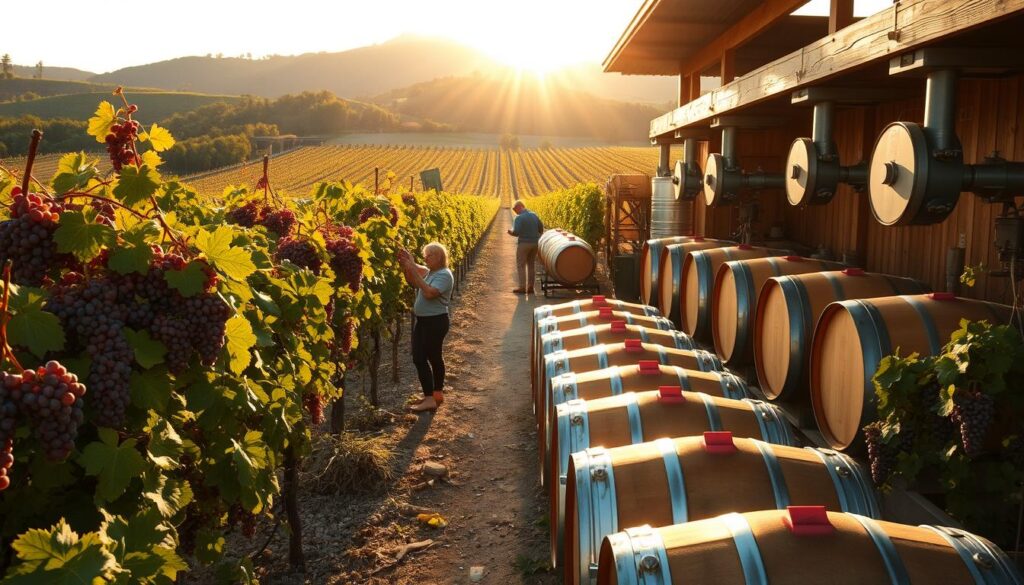
Modern advancements have revolutionized traditional red wine making techniques. Mechanical harvesters and stainless steel tanks have made the process more efficient, ensuring the highest quality in the final product. The rising global demand for red wine encourages innovation while preserving the rich heritage of winemaking.
| Grape Variety | Regions | Taste Profile |
|---|---|---|
| Cabernet Sauvignon | Bordeaux, California | Bold, full-bodied |
| Pinot Noir | Burgundy, Oregon | Lighter, delicate |
Winemaking remains an inspiring blend of science, intuition, and craftsmanship. Engaging in wine tasting and exploring various production techniques will deepen your appreciation for this timeless art form. Enjoy the journey of learning about wine; it’s a delightful adventure that tantalizes the senses and fosters connections with others who share your passion.
The Unique Elements of Wine Culture
Wine culture is rich with unique elements that enhance social rituals and culinary experiences. The significance of wine in gatherings cannot be overstated, as it often acts as a catalyst for conversation and connection. The blend of various wine culture elements allows you to engage more deeply with those around you, creating shared memories over a glass of your favorite wine.
Food pairings play an essential role in this cultural fabric. Pairing the right wine with a dish can elevate both the food and the beverage, resulting in a harmonious dining experience. Understanding which wines complement specific foods transforms not just your palate but the entire meal. For example, pairing a robust Cabernet Sauvignon with a juicy steak enhances the flavors of both, making for an unforgettable gastronomic delight.
Social rituals surrounding wine vary across cultures but often include toasting, sharing stories, and participating in harvest celebrations. These gatherings celebrate not only the wine itself but the process and craftsmanship behind it. Each region often has its unique traditions that highlight local wine varieties, showing how wine interweaves with various aspects of life and community.
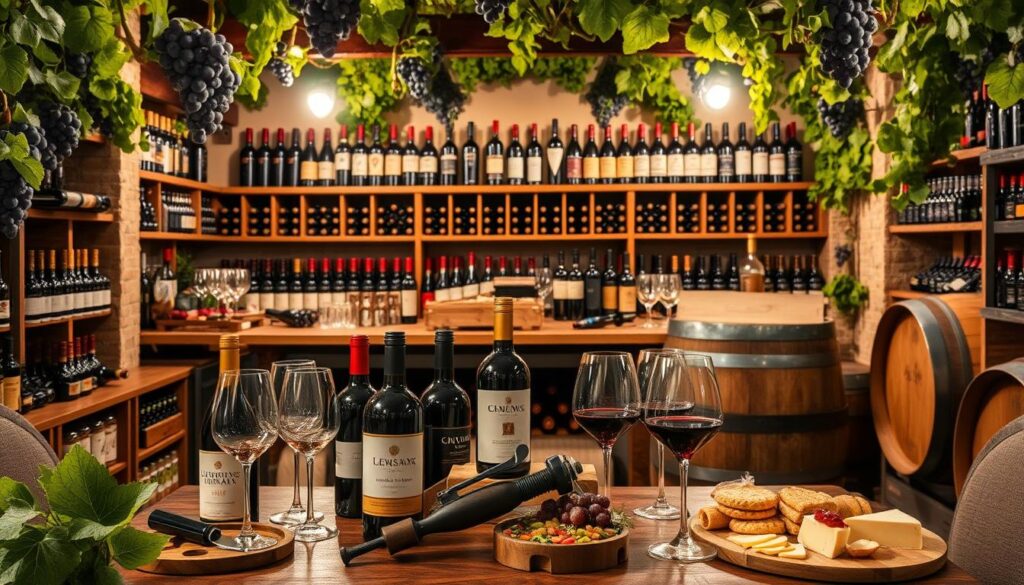
With the rise of modern wine appreciation, it’s important to embrace these elements to fully engage with wine culture. Whether you are tasting, pairing, or simply enjoying a glass with friends, the social rituals and culinary significance of wine create a rich tapestry of experiences. Understanding these vital concepts enhances your enjoyment and knowledge, allowing you to become a more informed wine enthusiast.
| Wine Type | Food Pairing | Social Ritual |
|---|---|---|
| Chardonnay | Grilled seafood | Toasting during celebrations |
| Merlot | Roasted chicken | Sharing stories of wine experiences |
| Pinot Noir | Mushroom dishes | Participating in vineyard tours |
| Cabernet Sauvignon | Grilled lamb | Harvest festival celebrations |
| Sauvignon Blanc | Goat cheese salad | Wine tasting events |
Wine Tasting Rituals: Mastering the Experience
Wine tasting rituals elevate your experience, turning each sip into a sensory experience. Engaging with wine through established tasting techniques allows you to appreciate its complexity. Begin by examining the wine’s appearance in the glass, observing its color and clarity. Next, swirling the wine releases aromas, inviting you to delve deeper into its scents before taking a sip.
As you focus on the flavor, use your palate to identify the different elements at play. For small gatherings, consider serving 5 to 7 wines, with each bottle accommodating approximately 5 to 6 guests given generous pours. If opting for more modest two-ounce pours, anticipate serving about 12 people from a single bottle. These wine tasting rituals encourage conversation and engagement among friends, transforming a simple gathering into an interactive experience.
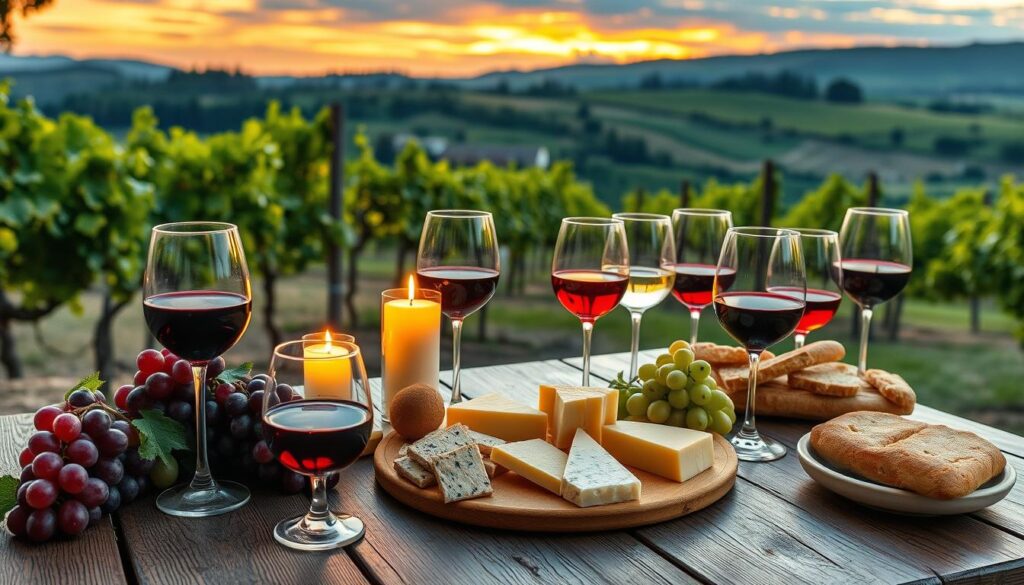
To further enhance the evening, collaborating with a chef can lead to remarkable pairing of food with wine. You might decide to have guests contribute to food costs or work together to create a cohesive menu. Presentation matters; bite-sized dishes encourage mingling and can be complemented by a carefully curated playlist that matches your party’s theme. Inviting friends to share stories about the wines encourages a lively atmosphere and keeps the experience dynamic.
Offering a surprise nightcap, such as a unique spirit, as guests leave can round out the festivities nicely. Engaging with wine does not just stop at tasting; it develops into an exploration of the stories and emotions behind each bottle, creating lasting memories that celebrate the beauty of wine.
The Role of Terroir in Wine Diversity
Terroir embodies the essence of a wine’s character, influenced by soil, climate, and the unique vineyard practices utilized by winemakers. Each factor plays a significant role in shaping wine diversity, as the same grape variety can yield distinct flavors and characteristics when grown in different terroirs. A closer look at terroir reveals how various environmental elements truly make a difference.
Climate refers to the long-term weather patterns in specific regions, including temperature and rainfall. For instance, Bordeaux enjoys consistent moderate climates, which enable grapevines to thrive. A warmer climate generally produces riper grapes, while cooler conditions yield more acidic fruit. These variations in climate heavily impact grape ripening and ultimately the quality of the wine.
Soil composition adds another layer to the complexity of terroir. Different mineral and earthy notes in grapes result directly from the type of soil. While scientific understanding of how soil composition influences wine flavor remains ambiguous, it is clear that nutrient interactions significantly affect grapevine chemistry, and consequently, the flavors of the wine produced. Each vineyard’s specific terroir presents unique conditions that lend individuality to wines.
Below is a comprehensive table illustrating how soil and climate contribute to wine diversity in different regions:
| Region | Soil Type | Climate | Grape Varieties | Characteristic Flavors |
|---|---|---|---|---|
| Bordeaux | Clay, Limestone | Moderate | Cabernet Sauvignon, Merlot | Blackcurrant, Plum |
| Burgundy | Clay, Chalk | Continental | Pinot Noir, Chardonnay | Cherry, Earth |
| Rheingau | Slate, Gravel | Cool Continental | Riesling, Spätburgunder | Peach, Apricot |
| California | Sandy, Clay Loam | Mediterranean | Chardonnay, Zinfandel | Tropical Fruits, Spice |
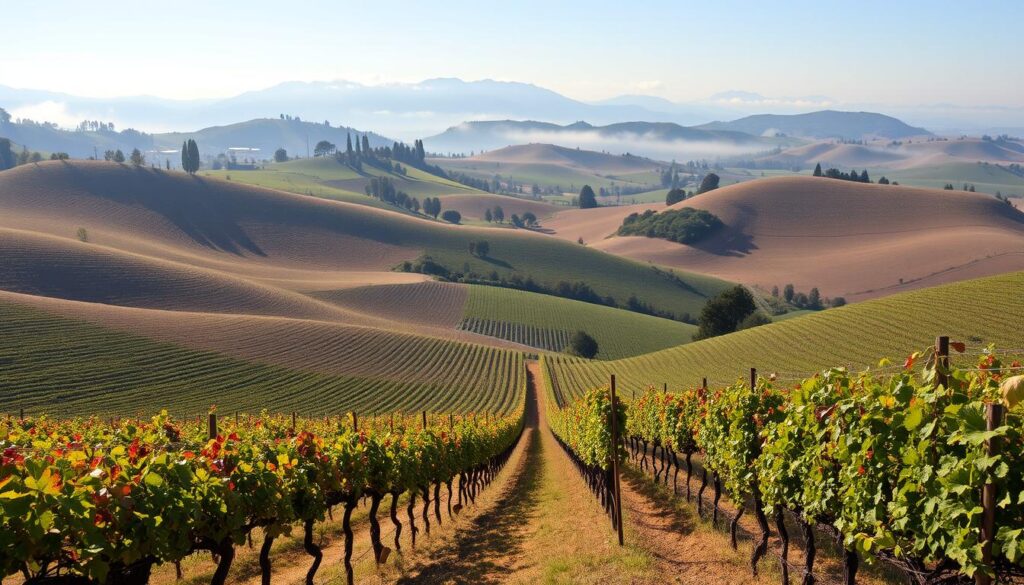
Winemakers often adapt their practices to the specific terroir of their vineyards, enhancing the final product. Techniques such as precise canopy management and controlled irrigation aim to optimize grape maturation, ensuring the best potential for flavor development. Understanding the interplay of soil, climate, and vineyard management is key to unlocking the true diversity found in wines worldwide.
Wine Appreciation Events: Connecting Wine Enthusiasts
Wine appreciation events serve as the ideal gatherings for connecting wine enthusiasts with a shared passion for tasting experiences. These events present opportunities to explore a diverse array of wines while fostering a sense of community among participants. From intimate tastings to large-scale festivals, each occasion brings something unique to the table.
For instance, the Karakterre Natural Wine Festival in New York City highlights organic, biodynamic, and natural wines from Austria and neighboring countries. This annual festival allows attendees to discover the rich flavors of these unique wines while networking with like-minded individuals. Similarly, the Charleston Wine + Food Festival in South Carolina combines Southern cuisine with exceptional wine offerings over five delightful days.
Another remarkable event is TASTE: The Livermore Valley Wine Experience, which showcases wine pairing competitions, food-themed activities, and educational sessions in Livermore, California. The La Paulée wine event, occurring in San Francisco and New York City, focuses on Burgundy wines, offering tastings and seminars that enrich participants’ knowledge of this esteemed wine region.
Beyond traditional tastings, festivals like the San Diego Bay Food + Wine Festival and South Beach Wine & Food Festival celebrate culinary innovation alongside wine, providing attendees a chance to indulge in a variety of culinary experiences. To dive deeper into regional offerings, Taste Washington showcases over 200 wineries and includes wine dinners and expert panels for a comprehensive experience.
Your exploration of wine culture can continue with events such as the Food & Wine Classic in Aspen and the Santa Fe Wine & Chile Fiesta, both offering picturesque settings paired with extraordinary wines. Other notable mentions include Healdsburg Wine & Food Experience and Two Up Wine Down in Charlottesville, where unique tasting experiences await all attendees.
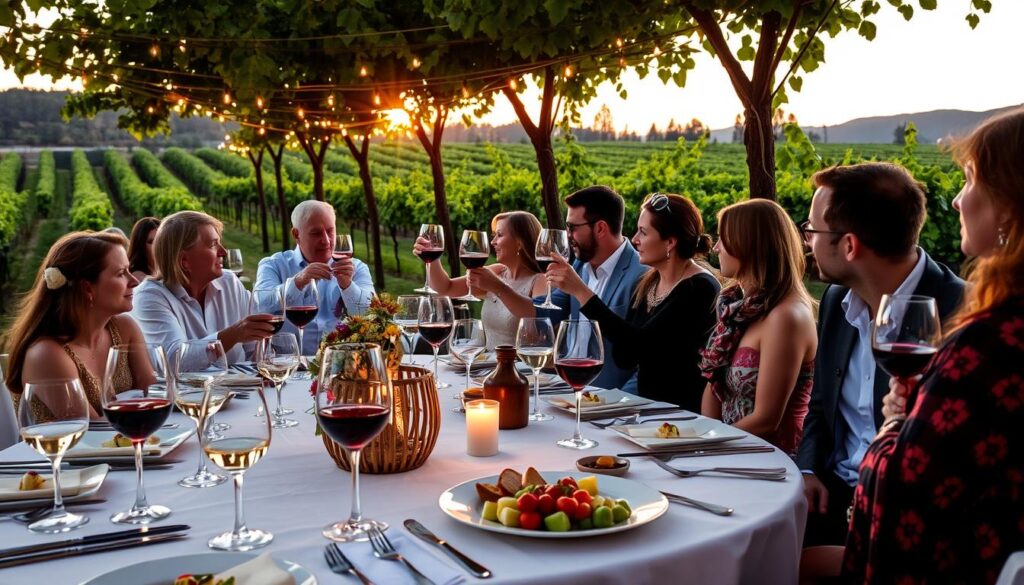
New England stands out as a premier destination for vineyard events, catering to both seasoned connoisseurs and curious foodies. With a year-round schedule of seasonal gatherings, vineyard events provide guided tours, wine tastings, and food pairings. Whether it’s spring festivals, summer al fresco gatherings, or fall harvest celebrations, each event highlights the synergy between wine and food amidst breathtaking landscapes.
The Wine & Culture Fest in Atlanta emphasizes cultural enrichment and networking, offering various activities including tastings, masterclasses, and panel discussions. Scheduled from July 23 to July 30, this evolving festival plays a vital role in connecting diverse communities with the wine industry.
| Event | Location | Highlights |
|---|---|---|
| Karakterre Natural Wine Festival | New York City | Organic, biodynamic wines from Austria |
| Charleston Wine + Food Festival | South Carolina | Southern cuisine and wine offerings |
| TASTE: Livermore Valley Wine Experience | Livermore, California | Wine pairing competitions and educational sessions |
| La Paulée | San Francisco & New York City | Tastings of Burgundy wines |
| San Diego Bay Food + Wine Festival | California | Over 800 wine producers and culinary experiences |
| Food & Wine Classic | Aspen, Colorado | Cooking demos and grand tastings |
| Wine & Culture Fest | Atlanta | Tastings and cultural showcases |
These wine appreciation events not only highlight the intricacies of winemaking but also offer enriching social experiences. Whether you are attending a festival or a vineyard event, there’s always something new to learn and taste in the world of wine.
Modern Trends in Wine Culture
The landscape of wine culture is evolving as consumers increasingly prioritize sustainability, health, and ethical practices in viticulture and vinification. As you explore these global wine trends, you’ll find that organic wines are gaining significant traction, driven by a collective demand for eco-friendly options. In the U.S., sales of organic wines reached an impressive $373 million in 2020, marking a notable growth of 17%. This indicates a clear shift towards wines that not only delight the palate but also align with your values regarding environmental stewardship.
Moreover, the rise of low-intervention winemaking techniques reflects the growing interest in ecological balance and health-conscious choices. Emerging wine regions are seizing this opportunity, as climate change reshapes the traditional landscape of winemaking. Regions like England and Northern Europe are now budding hotspots for innovative wines produced from hybrid and indigenous grape varieties, offering resilience against extreme weather conditions and a taste of sustainability.
With the digital transformation of the wine industry, e-commerce has surged, providing an accessible avenue for you to discover unique bottles from around the world. From alcohol-free wines appealing to designated drivers and health-focused consumers to alternative wine containers like cans and bag-in-boxes reducing carbon footprints, these modern trends keep you connected to a rapidly changing wine culture. Whether you’re seeking a luxurious bottle from esteemed brands or a quenching organic option, understanding these trends will enrich your wine journey.
